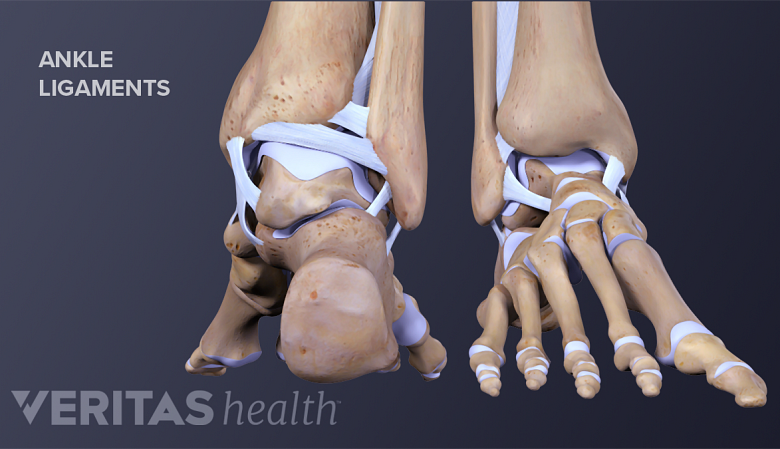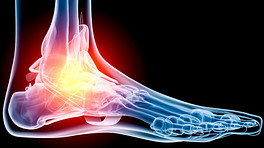Some people have a higher risk of developing ankle sprains and strains than others. Some risk factors are lifestyle-related and therefore preventable, while others are related to gender and age, and therefore not preventable.
Trauma to the ligaments of the ankle is a risk factor for ankle pain.
In This Article:
Risk factors for developing ankle sprains and strains include, but are not limited to:
Poor athletic conditioning. Anyone who attempts strenuous athletic activities without prior conditioning, such as a regular routine of ankle and calf stretching and strengthening exercises, runs an increased risk of spraining or straining the ankle ligaments and muscles during activity.
Muscle and ligament fatigue. When muscles and ligaments become fatigued at or near the end of a vigorous activity, people run a higher risk of injury if they “push through” the fatigue in pursuit of more activity instead of resting. For example, someone running a marathon may run a higher risk of ankle sprains or strains during the last few miles of the race.
Not warming up before activity. Athletes who go right into vigorous activity without doing a gradual warmup session beforehand, such as gentle stretching and walking before starting a sprint, run a higher risk of ankle sprains and strains. Without a warmup period, muscles and ligaments will remain tight, and less flexibility means greater risk for stretches and tears. 1 Mayo Clinic. Sprains and strains. Patient Care and Health Info, October 25, 2011: http://www.mayoclinic.org/diseases-conditions/sprains-and-strains/basics/definition/con-20020958. Accessed November 18, 2014.
Carrying excess weight. Excess weight places greater impact load onto the joints when walking, running, and jumping, which can increase the likelihood that ligaments and/or muscles will be stretched or torn during activity. 2 Malachy P, McHugh MP et al. Risk factors for noncontact ankle sprains in high school football players: the role of previous ankle sprains and body mass index. Am J Sports Med. 2006 Mar; 34(3):471-5. doi:10.1177/0363546505280429 Some studies indicate that the risk of developing ankle sprains and strains is slightly higher for overweight males than for overweight females. 3 Malachy P, McHugh MP, et al. Risk factors for noncontact ankle sprains in high school athletes: the role of hip strength and balance ability. Am J Sports Med, March 2006; 34 (3):464-470. doi:10.1177/0363546505280427
Female gender in athletes over 30 (ankle sprains only). Several studies have indicated that females over age 30 are at a significantly higher risk of developing ankle sprains than males in that age group, independent of their body mass index. 4 Waterman BR, Owens BD et al. The epidemiology of ankle sprains in the United States. J Bone Joint Surg Am. 2010 Oct 6;92 (13):2279-84. doi: 10.2106/JBJS.I.01537.
Male gender in young athletes, age 15-24 (ankle sprains only). In teenage and young adult athletes, males appear to have a higher incidence of ankle sprain than their female counterparts in the same age group.
Inappropriate footwear. Not wearing supportive footwear that is designed for the specific type of playing or walking surface being used can increase risk for developing ankle sprains and strains. For example, wearing high-heeled shoes while walking on an uneven or icy surface, or wearing low-topped shoes instead of high-tops when playing basketball. 5 Barrett J, Bilisko T. The role of shoes in the prevention of ankle sprains. Sports Medicine.
Prior history of sprains or strains. Persons who have had sprains or strains in the past have a higher risk of undergoing the same injury again than persons who have never had an ankle sprain or strain. 6 Beynnon B, Murphy D, and Alosa D. Predictive factors for lateral ankle sprains: a literature review. J Athl Train. 2002 Oct-Dec; 37(4): 376–380.
Patients with one or more of the above risk factors are advised to seek prompt medical attention if they suspect an ankle sprain or strain, especially if they have a history of repeated ankle injuries. Patients can also reduce their risk of injury by improving their athletic conditioning, strength, and flexibility.
- 1 Mayo Clinic. Sprains and strains. Patient Care and Health Info, October 25, 2011: http://www.mayoclinic.org/diseases-conditions/sprains-and-strains/basics/definition/con-20020958. Accessed November 18, 2014.
- 2 Malachy P, McHugh MP et al. Risk factors for noncontact ankle sprains in high school football players: the role of previous ankle sprains and body mass index. Am J Sports Med. 2006 Mar; 34(3):471-5. doi:10.1177/0363546505280429
- 3 Malachy P, McHugh MP, et al. Risk factors for noncontact ankle sprains in high school athletes: the role of hip strength and balance ability. Am J Sports Med, March 2006; 34 (3):464-470. doi:10.1177/0363546505280427
- 4 Waterman BR, Owens BD et al. The epidemiology of ankle sprains in the United States. J Bone Joint Surg Am. 2010 Oct 6;92 (13):2279-84. doi: 10.2106/JBJS.I.01537.
- 5 Barrett J, Bilisko T. The role of shoes in the prevention of ankle sprains. Sports Medicine.
- 6 Beynnon B, Murphy D, and Alosa D. Predictive factors for lateral ankle sprains: a literature review. J Athl Train. 2002 Oct-Dec; 37(4): 376–380.







